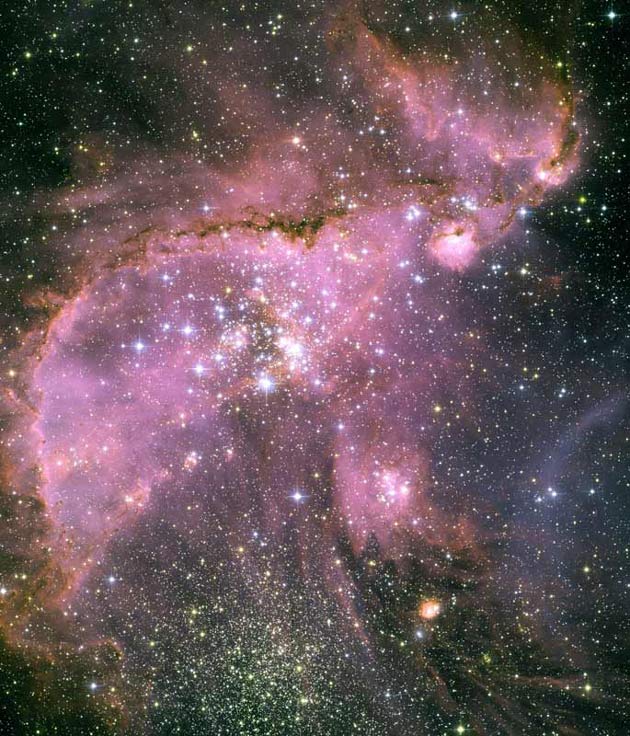Hubble Sees Stars as They're Born

A new Hubble Space Telescope image reveals stars just in the process of being born amid a fantastic scene of wispy space structures and intense radiation.
The stars have yet to condense into small enough packages to trigger thermonuclear fusion, which is what powers stars, but they appear to be on the verge, astronomers said today.
The setting is 210,000 light-years away in the Small Magellanic Cloud (SMC), a satellite galaxy of our Milky Way. At the center of the region is a brilliant star cluster called NGC 346. Arched and ragged filaments with a distinct ridge surround the cluster.
Radiation from the cluster's hot stars eats into denser areas, creating the features. The dark, intricately beaded edge of the ridge, seen in silhouette, contains several small dust globules that point back towards the central cluster, like windsocks caught in a gale.
Energetic outflows and radiation from hot young stars erode the dense outer portions of the star-forming region, formally known as N66, exposing new stellar nurseries. The diffuse fringes of the nebula prevent the energetic outflows from streaming directly away from the cluster, leaving instead a trail of filaments marking the swirling path of the outflows, astronomers said.
The NGC 346 cluster, at the center of the new picture, is resolved into at least three sub-clusters and collectively contains dozens of hot, blue, high-mass stars, more than half of the known high-mass stars in the entire SMC galaxy. A myriad of smaller, compact clusters is also visible throughout the region.
A rich population of infant stars is scattered around the young cluster NGC 346, reports a team led by Antonella Nota of the Space Telescope Science Institute/European Space Agency in Baltimore. These stars are likely to have formed 3 to 5 million years ago, together with the other stars in the NGC 346 cluster.
Breaking space news, the latest updates on rocket launches, skywatching events and more!
These infant stars are particularly interesting as they have not yet contracted to the point where their interiors are hot enough to convert hydrogen to helium.
The findings will be detailed in the Astrophysical Journal Letters.
The Small and Large Magellanic Clouds are diffuse irregular galaxies visible to the naked eye in the southern hemisphere. They are two smallish satellite galaxies that orbit our own Milky Way Galaxy and will eventually merge with it.
- Hubble's New Views of the Universe
- Hubble Space Telescope: Greatest Hits
- Hubble's New Era

Space.com is the premier source of space exploration, innovation and astronomy news, chronicling (and celebrating) humanity's ongoing expansion across the final frontier. Originally founded in 1999, Space.com is, and always has been, the passion of writers and editors who are space fans and also trained journalists. Our current news team consists of Editor-in-Chief Tariq Malik; Editor Hanneke Weitering, Senior Space Writer Mike Wall; Senior Writer Meghan Bartels; Senior Writer Chelsea Gohd, Senior Writer Tereza Pultarova and Staff Writer Alexander Cox, focusing on e-commerce. Senior Producer Steve Spaleta oversees our space videos, with Diana Whitcroft as our Social Media Editor.
